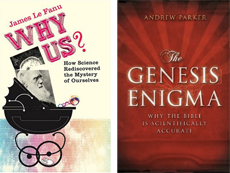Review of Genesis Enigma and Why us? by Andrew Parker and James Le Fanu

I was not thrilled to be handed two huge tomes of scientific material to plough through and review. However the writing in both these books is surprisingly clear and interesting; and the conclusions of both writers are astonishing.
Rather than modern science delivering the death blow to religion, both authors contend that from an evolutionary science and a medical science background, there is evidence for the existence of God, and a need to embrace mystery and faith.
Andrew Parker discovered the Genesis Enigma while on a tour of the Vatican in Rome. He saw Michelangelo's painting in the Sistine Chapel, with its depiction of the steps of creation from Genesis, and he suddenly realised that the most modern discoveries of science actually back up the order of creation described in the first chapter of Genesis:
Let there be light: Formation of the sun (5,000M yrs ago)
Waters separated from the land: Formation of seas and land separated (4,200M)
Vegetation, seed-bearing plants and trees: Beginnings of life including plants (3,900M)
Lights dividing day and night: Beginning of vision (521M)
Fish and birds: Marine life dominated, then birds
Living creatures: More complex animals developed
The fourth step is the one he has been most criticised for, since a normal reading of those verses would seem to indicate the creation of the sun and moon. However, Parker points out that the creation of the sun has been referred to on the first day, why repeat? Whereas a more logical conclusion would be referral to the first moment that vision was detected, with the ability to discern between night and day.
Parker himself discovered the beginning of vision, and its place as the "big bang" moment of evolution, the point at which predators were more able to identify prey, causing prey to evolve more quickly.
His conclusion is that the author must either have had divine inspiration or made an extremely lucky (and rather unlikely) guess. His own opinion is that Genesis is evidence of God's hand in the Bible.
James le Fanu comes from a background as a medical doctor and writer for quality journals such as The Lancet, New Statesman and New Scientist. He examined the thirty major scientific discoveries in the last 60 years which include such marvels as the atom bomb, walking on the moon, test tube babies and the Human Genome project.
His conclusion is that rather than delivering certainty, all these scientific discoveries have opened up the mystery of life. We know so much, but there is so much more to be known. He also raises the possibility that science will never deliver the certainty that was promised by Darwin and Freud.
The specific mysteries he points to include: altruism = something that means we put others before ourselves, possibly lessening our own chances of survival; the existence of free will, the ability to choose and not just respond to automatic instincts; and the fact that both of us might be here at the same time with the same inputs but have completely individual experiences, resulting from our own history and our different perceptions and emotional interpretations.
Other mysteries which may never be explained by a materialist scientific approach: the richness and accessibility of memory = our brain can sort through experiences and remember not just the visuals but the feelings associated with that event; human reason and imagination = higher functions that eclipse our ability to understand, reproduce or even predict; the self = the non-material being that is distinctive, and unique.
Le Fanu contradicts Richard Dawkins and the New Atheism. He asserts it is rational to have faith because science reveals the mystery of life. Rather than faith being an excuse to avoid thinking and evaluating evidence, it can be seen as the art of holding onto things your reason has accepted.
He ends with a call for a renewed sympathy with religion, and an embracing of our Christian heritage; as well as a deepened respect for the unexplained and unfathomable beauty and diversity of the planet around us.
What are we to make of these new books? Their similarities are striking:
"¢ Both mention Alister McGrath in their acknowledgements as helping to challenge and shape their thinking
"¢ Both quote Christian theologian and writer CS Lewis
"¢ Both mention the mind and spirit-expanding influence of the paintings of Michelangelo
"¢ Both commenced from a point of religious scepticism but end up willing to embrace notions of faith and the existence of God.
While we cannot wheel out these books as arguments for the truth of the Gospel message, we can point to the death of materialist certainty as a philosophy; the willingness of new science to embrace mystery and the possibility of God; and the reliability of the biblical record. It is also important to note how great Christian thinkers and artists can have a pervasive influence through their work and their conversations. It is an encouragement for us to try and influence those around us.
KARA MARTIN is a lecturer with School of Christian Studies (www.socs.org.au), and is an avid reader and book group attendee. Kara does book reviews for Hope 1032's Open House (www.theopenhouse.net.au).


















